|
What keeps the last Assyrians of northern Iraq going against all odds? August Thiry, photographer Geert Segers and their guide and interpreter Melkan Ishak went to Iraqi Kurdistan in the early summer of 2004. They got free passage to the small territory of a Christian minority – Little Assyria. August Thiry - Photography : Geert Segers
Welcome to Kurdistan
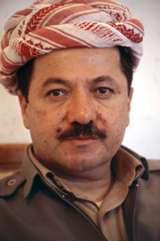 Massud Barzani
The first impression is a surrealist view: Welcome to Kurdistan of Iraq on a large signboard, just a bridge length away from Turkish denial. In the customs office we are queuing up for the official sheet with seal, which promises free passage. I notice the portrait on the wall. Kurdish Democratic Party-leader Massud Barzani glances back and seems to keep his eyes on every visitor. The picture of the KDP-head, who dominates the greater part of northern Iraq, will soon follow us everywhere on our journey through so-called Free Kurdistan.
Ankawa
It is a two-hundred-kilometers’ ride from the border to Arbil, the seat of the Kurdish regional parliament in northern Iraq. On the first day of February 2004 a suicide terrorist entered the building where a reception was staged on the occasion of the Islamic Feast of Sacrifice. A terrible explosion followed. It killed a large number of Kurdish politicians and other leading figures. This murderous assault has apparently left its marks. When we reach the centre of Arbil, we pass the recently built huge wall that completely surrounds the parliament and protects it behind reinforced concrete. It may be a necessary safety belt, but it is also a sad sight, and a bad omen for democracy in this Kurdish region.
Ankawa is an isolated suburb close to Arbil Airport. This is the area where about twelve thousand Chaldo-Assyrian Christians live. It seems to be a rather prosperous place with many shops and large houses behind walled front gardens. Even at sunset the heat is stifling, but there are also beautiful moments to catch: the unexpected sight of unveiled young women with bare shoulders, walking in jeans and tops under the street lighting.
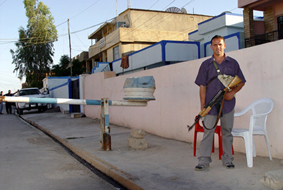 ADM offices Ankawa
Yonan Hozaya is regional Minister of Industry and one of the five Assyrians in the Kurdish parliament. After 1992 there haven’t been new elections in Iraqi Kurdistan and since then the balance of power has remained the same. That means fifty seats in the Kurdish parliament for Barzani’s KDP and also fifty for PUK or Patriotic Union of Kurdistan, headed by Jalal Talabani, who controls the south-eastern part of this Free Kurdistan, close to the border with Iran. In spite of this overwhelming Kurdish majority, Yonan Hozaya is a man of some importance. He looks tired, he has the hoarse voice of the heavy smoker and he can hardly control the nervous movements that make his right arm tremble.
Law and Order
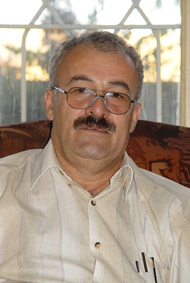 Yonan Hozaya
‘Now the Americans have decided to hand over the power at last. I am afraid it comes too late, I don’t expect that even after the general elections next year the new Iraqi government will be able to get everything under control. You just have to look round. The policemen are moving targets, they cannot even protect themselves against terrorist attacks. And the respect for the American troops has gone. Remember all that fuss abroad about those prisoners who were supposedly humiliated in the Abu Greib prison. So what? Most of these would-be victims were criminals suspected of terrorism. We Iraqi’s, we know better how to treat that scum. We would have finished them off without taking pictures. The Americans understand nothing about this country. In the Nineveh plain for instance there has never been any control by units of the coalition. ADM has asked for military protection many times; all in vain. What good can come from occupying forces that cannot even restore law and order?’
Our Assyrian guide Ishak suddenly butts in and speaks his mind. ADM should above all see to it that the Iraqi Assyrians get an autonomous area in the Nineveh plain. Even a few square miles would do. And then they would put a sign there: Welcome to Little Assyria of Iraq. According to him it is not utterly ridiculous, it might be picked up by the international media and so it could incite emigrated Assyrians in Europe, America and all over the world to invest more in the ancient Assyrian homeland.
Hozaya smiles patiently, he finds it an amusing idea. ‘A few square miles won’t save us,’ he goes on. ‘The Assyrians of Iraq have grown too weak. Seventy to eighty per cent of our people are now living in Baghdad and we cannot survive here in the north without peace and democracy. But we are expecting a lot from the Assyrian communities abroad. The Kurds in Iraq and elsewhere have constantly been pleading for a Free Kurdistan and indeed, it has paid off at last. Our emigrants in the worldwide diaspora should do the same thing: defend the Assyrian cause while appealing to their governments abroad. And when may we have the honour to welcome them back? It is all too easy for them to return home when everything is safe and sound. We need them now, with their education, their connections and their money. If this fails, I fear that we cannot even hold our last villages in the Nineveh plain.’
Little Assyria
The Nineveh plain east of Mosul is a sweltering desert. It is Sunday morning and in Karakosh the church bells are tolling. More than 25.000 Christians live in this small town and in the adjacent villages. Even here emigration has cut down the population. They went to the south of Iraq, mainly to Basra, to find work, but most of them are now planning to come back as soon as they can. ‘Karakosh is home,’ says Qasha Elias. ‘In Sureth, our own Aramaic language, we call this place Bagdeda, that means House of the People.’
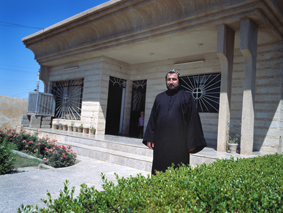 Syrian-Orthodox Qasha at Bagdeda
There are seven churches in Bagdeda and Qasha Elias shows us around. He wears the traditional long habit and the black cap with thirteen white crosses on it, representing Christ and the twelve apostles. He is worried, he says, while wiping the sweat from his forehead. The Christian enclave in the Nineveh plain belongs in fact to the Arab province of Mosul beyond Kurdish territory. It doesn’t prevent the Kurdish authorities in the north from expanding their influence towards the Mosul area; attracted as they are by the smell of the black gold that comes from the oil wells in this province. Barzani’s KDP has already opened a party office in Bagdeda. ‘People are queuing up there,’says Qasha Elias. ‘Can you blame them? The KDP is well-organized, even Christians who join them can get things done much quicker. And above all, we have realized by now who is coming here to stay and who is not.’
We can see for ourselves what he means when we reach the village of Karmliss, close to Bagdeda. Its impressive church is guarded by a young shamasha or deacon, who has a kalashnikov within his arm’s reach. He is prepared to talk if his name is not mentioned, and he guides us to the village school. This primary school has recently been renovated.
We see a brand-new water cooler at the entrance and the walls of the classrooms have been painted. The deacon explains what happened. After the fall of Saddam American soldiers came to Karmliss. They went on patrol in the neighbourhood and in between they occupied themselves with tidying up the school. ‘They didn’t stay long,’ says the deacon. ‘We had high hopes at first and I still think they could have done a lot more for the village. But that’s the way is is, they came and they went.’
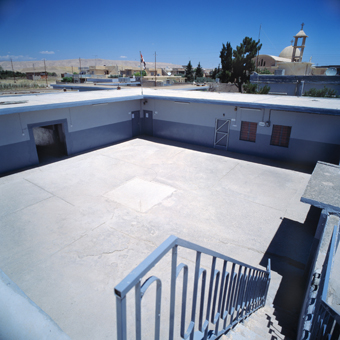 School at Karmliss
Chaldean View
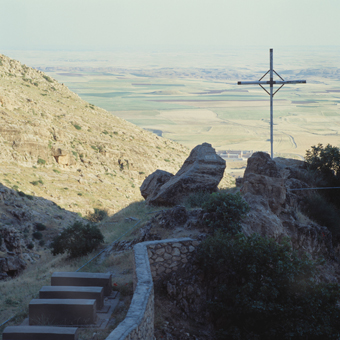 Rabban Hormizd monastery - Alqosh
In Alqosh there was also a Jewish community. To them it was the place where the biblical prophet Yonah, who figures in the Old testament, was buried. In 1948 these Alqosh-Jews emigrated to their Promised Land, Israel, and since then the Christians of Alqosh take care of Yonah’s shrine, which is preserved in the Bar Micha, the church of Holy Michael.
A common Jewish-Christian tradition still survives in Alqosh. On the other hand the relations between Assyrian and Chaldean Christians remain a point of hard discussion. And this in spite of the common name Chaldo-Assyrians, which was adopted at the end of 2003 at the Baghdad Conference of all Aramaic-speaking Christians of Iraq.
The problem already became clear in Tel Keyf, just to the north of Mosul. We made a stop there, before going on to Alqosh, and met with a Chaldean priest. He wanted to be called Père Mathieu, without further comment. He got his theological education at the seminary of the French Dominicans in Mosul and considering his cassock, trimmed grey beard and sharp look, he could easily be taken for an old-fashioned Catholic abbé. The Assyrian Cause? Père Mathieu shakes his head and pronounces his Chaldean view.
‘It is all one great myth, Christian people of Iraq descending from the ancient Assyrians. The British invented that nonsense after the excavations at Nineveh in the nineteenth century. They did this for their own political purposes, to stir up the Christians of Mesopotamia against the Ottoman Turks. And now our Christian politicians are pushing even harder to spoil everything with their call for Assyrian autonomy. It is madness. A minority locked up in the Nineveh plain, something like an Indian reservation in the USA, is it that what they want? Our own language for our own people, so they say. But what is that Assyrian, that Sureth, in fact? It is just an Aramaic idiom, a dialect that is spoken in the villages. For conversation on a higher level educated people in this country use Arabic, our real language of civilization. You shouln’t think that I am opposed to unity; on the contrary: we are all Iraqi Christians, and that is what really unites us, our deep-rooted Christian faith.’
What was his opinion about the Americans in Iraq? ‘Invasion and occupation,’ answered Père Mathieu,‘illegal and immoral.’ He touched his cheeks with both hands and then made them brush his grey beard. Critical reply was not expected, the conversation was over. An old habit perhaps. Even under Saddam Chaldean Christians didn’t have such a bad life: Catholic Rome supported them and they had connections in high places. Tariq Aziz for instance, Baath top executive and Chaldean Christian as well.
Massacre at Simele
Simele is a town about halfway on the main road from Mosul to the Turkish border. It is a notorious place, it remains connected with the brutal massacre of August 7, 1933. Assyrians all over the world commemorate the Day of the Assyrian Martyrs, as they call this tragic event. Its cause dates back to the First World War.
In those days the Assyrian-Nestorian mountaineers were still living as tribal communities in the Hakkari mountains in south-eastern Turkey. They were semi-independent ashiret-people under Turkish supervision and their religious and profane leader was known as patriarch Mar Shimun. In 1915 Mar Shimun declared war on Turkey. The Assyrian mountaineers were besieged by Turkish troops and Kurds and their only way out was to take refuge on Persian territory in the region of Lake Urmia and the city with the same name. In 1918 the Assyrian mountaineers and their families, in fact the whole Assyrian population, had to start another exodus from Urmia and they were finally sheltered by the British in Iraq, which was then under British protection.
These Assyrians were trained fighters and after the war the British used them as Assyrian Levies or combat units against Kurdish rebellions in the north of Iraq. Both the Kurds and the Arabs in the north saw them as collaborators with the foreign occupation, and hated them. It got worse when the British retreated from Iraq in 1933 and left the Assyrians to their fate. In the summer of that year an armed group of Assyrians tried to go to Syria by crossing the river Tigris. While doing so, they got involved in close combat with regular army forces and several Iraqi’s were killed. Afterwards an Iraqi military unit took revenge on the population of Simele, the nearest Assyrian village they went by. More than three hundred innocent people were gunned down and dumped in shallow mass graves. A hideous crime for sure. And yet, these Iraqi troops received a triumphant welcome in Mosul, where the Arab inhabitants had hung up bloodstained melons, pierced with knives. They represented the severed heads of the Assyrian traitors.
Bad Beerman
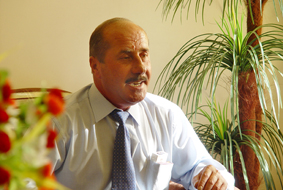 Semir Shamo
‘Very hard for me in Holland,’ says Semir. ‘No good life, big problems and bad beerman. Good morning, I speak. He not speak. Come my house, I speak. He not come. I have party. He speak: shut up, is late! No respect, you see. Here not so. You are guest. You stay long? No problem. Here is home. Kurd, Assyrian, no problem, all good.’
Beerman? Hard to translate Semir’s involuntary pun. It has nothing to do with drinking habits in Holland, he meant buurman, which is Dutch for neighbour. Anyway, Semir doesn’t seem to be preoccupied with his Assyrian identity. He has his connections at the local KDP-office, he has bought a large building lot in the new residential area and he has engaged a Kurdish friend and his family who have moved in with him. ‘Bad man Saddam finished,’ says Semir. ‘Good times now, many people come here and work, make nice houses, like in Europe.’ Semir has high hopes. I notice the portrait of Barzani on the wall of his spacious living, with a smaller image of the Virgin Mary next to it.
Semir’s place in Simele, summer of 2004. The future looked bright. It didn’t last long. One year later. We get news from Semir Shamo. He has sold his property in Simele to his Kurdish friend and he has left the north of Iraq or Free Kurdistan, a dubious country, which is not even allowed to show itself on the map. Semir has returned again to his old place in Holland, just across the Belgian border. He has made the best of a bad bargain. Little Assyria may be home, but Holland is sound and safe. In spite of the bad beerman.
|

 Homeland
Homeland  Iraq
Iraq  Little Assyria
Little Assyria

 Homeland
Homeland  Iraq
Iraq  Little Assyria
Little Assyria